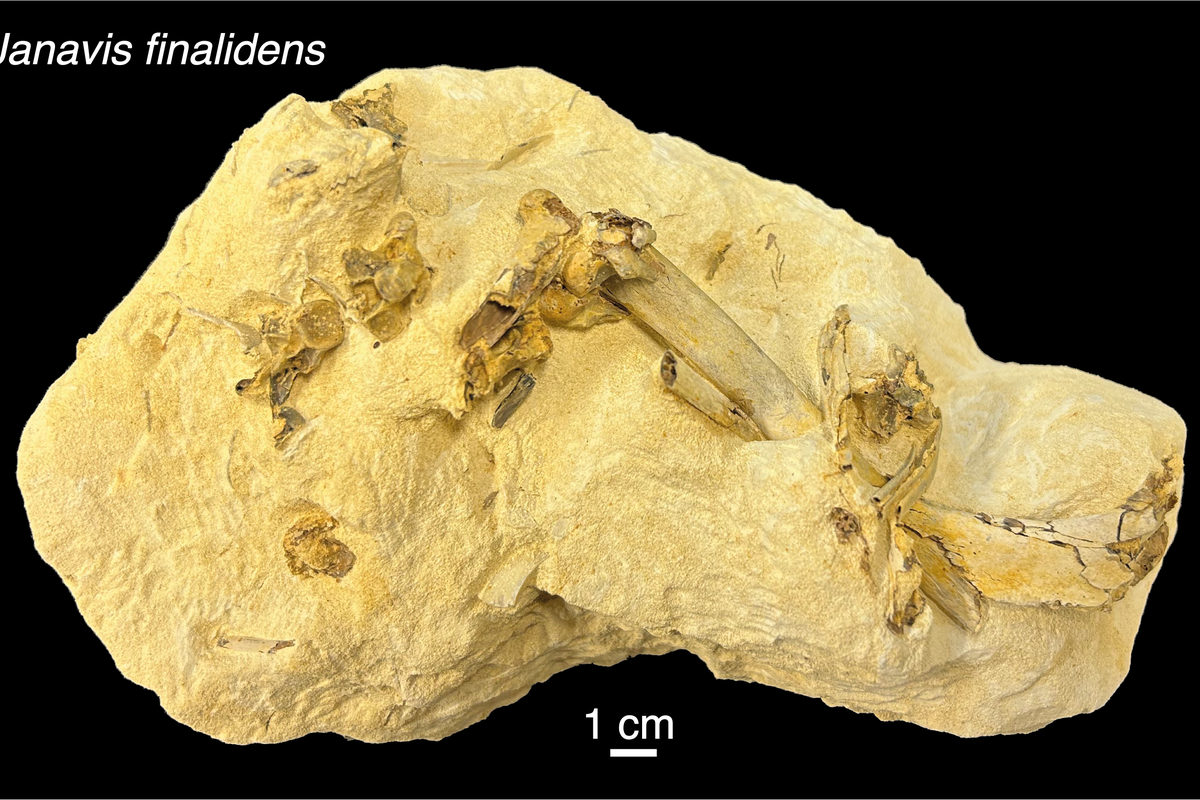Fossil ‘overturns more than a century of knowledge about origin of modern birds’

Fragments of a skeleton fossil hidden in a rock the size of a grapefruit have helped overturn more than a century of knowledge about the origin of modern birds, researchers say.
A new study found that one of the key skull features that characterises 99% of modern birds – a mobile beak – evolved before the mass extinction event that killed all large dinosaurs, 66 million years ago.
This finding also suggests the skulls of ostriches, emus and their relatives evolved backwards, reverting to a more primitive condition after modern birds arose.
Using scanning techniques, University of Cambridge researchers identified bones from the roof of the mouth (palate) of a new species of large ancient bird, which they named Janavis finalidens.
This fossil shows that the mobile beak – a condition we had always thought post-dated the origin of modern birds – actually evolved before modern birds existed
Dr Daniel Field, University of Cambridge
It lived at the very end of the Age of Dinosaurs and was one of the last toothed birds to ever live, the study suggests.
According to the Cambridge and Natuurhistorisch Museum Maastricht researchers, the arrangement of its palate bones shows the creature had a mobile, dexterous beak, almost indistinguishable from that of most modern birds.
For more than 100 years it had been thought that the mechanism enabling a mobile beak evolved after the extinction of the dinosaurs.
However, the new findings suggest that our understanding of how the modern bird skull came to be needs to be re-evaluated.
Dr Daniel Field, from Cambridge’s Department of Earth Sciences, the paper’s senior author, said: “This assumption has been taken as a given ever since.
“The main reason this assumption has lasted is that we haven’t had any well-preserved fossil bird palates from the period when modern birds originated.”
Each of the roughly 11,000 species of birds on Earth today is classified into one of two groups, based on the arrangement of their palate bones.
Ostriches, emus and their relatives are classified into the palaeognath, or “ancient jaw” group, meaning that, like humans, bones of the roof of their mouth are fused together.
We’ve been completely backwards in our assumptions of how the modern bird skull evolved for well over a century
Dr Daniel Field, University of Cambridge
All other groups of birds are classified into the neognath, or “modern jaw” group, meaning their palate bones are connected by a mobile joint.
This makes their beaks more dexterous, helpful for nest-building, grooming, food-gathering, and defence.
The two groups were originally classified in 1867 by Thomas Huxley, the British biologist known as “Darwin’s Bulldog” for his vocal support of Charles Darwin’s theory of evolution.
His assumption was that the ancient jaw configuration was the original condition for modern birds, with the modern jaw arising later.
The fossil, Janavis, was found in a limestone quarry near the Belgian-Dutch border in the 1990s and was first studied in 2002. It dates from 66.7 million years ago.
Because the fossil is encased in rock, scientists at the time could only base their descriptions on what they could see from the outside.
Some 20 years on the fossil was loaned to Dr Field’s group in Cambridge, and Dr Juan Benito, then a PhD student, started giving it another look.
He said: “Since this fossil was first described, we’ve started using CT scanning on fossils, which enables us to see through the rock and view the entire fossil.
We realised we’d seen a similar bone before, in a turkey skull. And because of the research we do at Cambridge, we happen to have things like turkey skulls in our lab, so we brought one out and the two bones were almost identical
Dr Juan Benito
“We had high hopes for this fossil – it was originally said to have skull material, which isn’t often preserved, but we couldn’t see anything that looked like it came from a skull in our CT scans, so we gave up and put the fossil aside.”
During the Covid-19 lockdown Dr Benito had another look at the specimen.
He said: “Then we realised we’d seen a similar bone before, in a turkey skull.
“And because of the research we do at Cambridge, we happen to have things like turkey skulls in our lab, so we brought one out and the two bones were almost identical.”
The finding led researchers to conclude that the unfused jaw condition, which turkeys share, evolved before the ancient jaw condition of ostriches and their relatives.
For an unknown reason, the fused palates must have evolved at some point after modern birds were already established, the researchers say.
Dr Field said: “Evolution doesn’t happen in a straight line.
“This fossil shows that the mobile beak – a condition we had always thought post-dated the origin of modern birds – actually evolved before modern birds existed.
“We’ve been completely backwards in our assumptions of how the modern bird skull evolved for well over a century.”
While this discovery does not mean the entire bird family tree needs to be redrawn, it does rewrite our understanding of a key evolutionary feature of modern birds, researchers say.
The findings are published in the journal Nature.
For all the latest Science News Click Here
For the latest news and updates, follow us on Google News.

